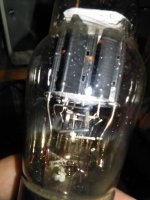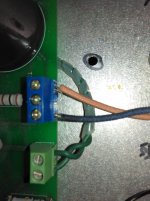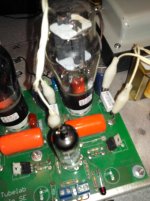One look at the pinout of 6N6G and it is immediately apparent that it is a drop in to the SSE, provided that, the voltage at pin 3 of the power tube is equal to or less than 300 volts.
When I pulled the Edcors off the CR SSE to use with the DHT modified SSE board, I replaced them with some small radio transformers, Merit A-2930, that have a 40 ma current limitation. The 6N6G is a pre dialed in tube, perfect for this low power application.
It is pre dialed in, because it contains it's own resistor network to set bias. In fact, it contains two triodes, one set up as a cathode follower, internally coupled to a triode power amplifier. Sort of a 1930's integrated circuit. If you look close at the first pic, you can see one of the resistors - it looks like a small fuse.
A good explanation of the why and how of twin triode is found here:
http://www.clarisonus.com/Archives/Amp_Design/New2B6.pdf
Note that with 2B6, it's plate resistance is roughly equivalent to its load impedance. That is not the case with 6N6G.
The most informative data sheet is probably the Triad sheet for the 6B5 which is an equivalent tube ( electrically, pin out is different ). It is attached here. ( Note that Sylvania, RCA, Tung Sol ( at least ) have published data sheets for 6N6G. There are subtle differences among them, but these differences are not consequential to use in the SSE. )
Anyway, with 6N6G, you apply X plate voltage and get Y current. That's it. No tinkering. We can see from the Triad data sheet that with an applied voltage of 250 volts, plate current of the power triode is 33 ma. My CR SSE sits at 253 volts, loaded. 6N6G is a perfect, no hassle, no solder and try fit, for the A-2930.
To use 6N6G in the SSE, the terminal block for the OPT's is wired in pentode configuration. That applies B+ voltage to the cathode follower triode. A jumper is then placed across the cathode resistor, as 6N6G requires the cathode of the power triode to be grounded ( it is pre biased, as previously noted ). Disconnect cathode feedback.
At first, I literally ran jumper clip leads across my existing bias resistors. Last night, I played with it some and put in 10 ohm resistors so I could meter across them.
The few threads on the internet, where people have built amps around 6N6G, report liking it. The peanut gallery tends to criticize the high plate resistance. There is some speculation the plate resistance specification is inaccurate. I believe it is accurate. The amplification factor is high, making them a good candidate for a low voltage SSE driven by a portable device.
Last night I played around with them some. The plate spec is 7K, and the data sheet shows they really want 7K. Regardless, I hooked up my 10 watt Transcendars, 5K, They struggle with the two tone IMD test with the 5K transformer when using 60 Hz ( the 6N6G, not the Transcendar ) but had no difficulty when I bumped the lower tone up to 200Hz. My filter cap in my CR SSE is rated at only 250 volts, but I did briefly try the tubes at 275 volts. I found that IMD was cut in half by this small increase in B+, so I would suggest running them at 300 volts, or 325 volts, if you have one of the brands that permit that.
My tubes have a pretty good spread of IMD characteristics. The best testing tubes are not necessarily the best performers. This is not unique to 6N6G.
Even with the small A-2930, I would place myself in the camp of liking the sound of the tube, I don't find anything objectionable about it, other than its cost and scarcity. There is also a low power variant, 6AB6G, I think. Forget about finding a real metal 6N6MG - I've never even seen one.
Win W5JAG
When I pulled the Edcors off the CR SSE to use with the DHT modified SSE board, I replaced them with some small radio transformers, Merit A-2930, that have a 40 ma current limitation. The 6N6G is a pre dialed in tube, perfect for this low power application.
It is pre dialed in, because it contains it's own resistor network to set bias. In fact, it contains two triodes, one set up as a cathode follower, internally coupled to a triode power amplifier. Sort of a 1930's integrated circuit. If you look close at the first pic, you can see one of the resistors - it looks like a small fuse.
A good explanation of the why and how of twin triode is found here:
http://www.clarisonus.com/Archives/Amp_Design/New2B6.pdf
Note that with 2B6, it's plate resistance is roughly equivalent to its load impedance. That is not the case with 6N6G.
The most informative data sheet is probably the Triad sheet for the 6B5 which is an equivalent tube ( electrically, pin out is different ). It is attached here. ( Note that Sylvania, RCA, Tung Sol ( at least ) have published data sheets for 6N6G. There are subtle differences among them, but these differences are not consequential to use in the SSE. )
Anyway, with 6N6G, you apply X plate voltage and get Y current. That's it. No tinkering. We can see from the Triad data sheet that with an applied voltage of 250 volts, plate current of the power triode is 33 ma. My CR SSE sits at 253 volts, loaded. 6N6G is a perfect, no hassle, no solder and try fit, for the A-2930.
To use 6N6G in the SSE, the terminal block for the OPT's is wired in pentode configuration. That applies B+ voltage to the cathode follower triode. A jumper is then placed across the cathode resistor, as 6N6G requires the cathode of the power triode to be grounded ( it is pre biased, as previously noted ). Disconnect cathode feedback.
At first, I literally ran jumper clip leads across my existing bias resistors. Last night, I played with it some and put in 10 ohm resistors so I could meter across them.
The few threads on the internet, where people have built amps around 6N6G, report liking it. The peanut gallery tends to criticize the high plate resistance. There is some speculation the plate resistance specification is inaccurate. I believe it is accurate. The amplification factor is high, making them a good candidate for a low voltage SSE driven by a portable device.
Last night I played around with them some. The plate spec is 7K, and the data sheet shows they really want 7K. Regardless, I hooked up my 10 watt Transcendars, 5K, They struggle with the two tone IMD test with the 5K transformer when using 60 Hz ( the 6N6G, not the Transcendar ) but had no difficulty when I bumped the lower tone up to 200Hz. My filter cap in my CR SSE is rated at only 250 volts, but I did briefly try the tubes at 275 volts. I found that IMD was cut in half by this small increase in B+, so I would suggest running them at 300 volts, or 325 volts, if you have one of the brands that permit that.
My tubes have a pretty good spread of IMD characteristics. The best testing tubes are not necessarily the best performers. This is not unique to 6N6G.
Even with the small A-2930, I would place myself in the camp of liking the sound of the tube, I don't find anything objectionable about it, other than its cost and scarcity. There is also a low power variant, 6AB6G, I think. Forget about finding a real metal 6N6MG - I've never even seen one.
Win W5JAG
Attachments
Last edited:
One look at the pinout of 6N6G and it is immediately apparent that it is a drop in to the SSE, provided that, the voltage at pin 3 of the power tube is equal to or less than 300 volts.
Even with the small A-2930, I would place myself in the camp of liking the sound of the tube, I don't find anything objectionable about it, other than its cost and scarcity. There is also a low power variant, 6AB6G, I think. Forget about finding a real metal 6N6MG - I've never even seen one.
Win W5JAG
I read about this tube a while back but didn't follow up on it due to its high cost, even for good used ones.
They're too expensive relative to the prices for NOS 6BG6, 6CD6, 6Y6 and others.
I'd like to try them if I can get a good pair at low cost.
So W5JAG, they should be run in pentode mode without the cathode bias resistor, voltage between 250V and say 290V, and without cathode feedback ?
The output stage of 6N6G is a triode, so it runs only as a class A triode. The terminal block is wired as if you were using a pentode.
The bias resistor is inside the tube, so the cathode goes direct to ground - no external bias is needed, and the existing bias resistor is jumpered, or replaced with a jumper.
With the cathode at ground, the cathode feedback will ground the speaker output. Just pull the wires from the cfb block, and leave it open.
They are expensive, but with patience you can probably find some at a reasonable price.
Win W5JAG
The bias resistor is inside the tube, so the cathode goes direct to ground - no external bias is needed, and the existing bias resistor is jumpered, or replaced with a jumper.
With the cathode at ground, the cathode feedback will ground the speaker output. Just pull the wires from the cfb block, and leave it open.
They are expensive, but with patience you can probably find some at a reasonable price.
Win W5JAG
Not much to report here - they seem to be working fine in the 250 volt configuration. There has been ample time for problems to arise, if that were going to happen.
I noted a few posts on this tube, speculating whether or not its reportedly high plate resistance was accurate. I believe it is. When I tested them on the bench, I noted that the tube seemed to struggle with low frequencies, even when connected to OPT's that have good low frequency response. That suggests to me that the tube does have a high plate resistance.
I am exaggerating that "problem" by using pathetically small Merit A-2930 5000:4 OPT's into an 8 ohm load, which should further diminish the low frequency response.
In spite of this, in actual operation, I'm not finding this to be that big a deal. It is driving 96 dB sensitive Klipsch speakers, so most of my listening requires very little power, probably not even 100 mW, and, although they have excellent low frequency response, I suspect that most listening material now a days has little really low, low frequency content. A bump of EQ off flat takes care of whatever problems are here.
So, I think I would still place myself in the camp of liking these. Although I'm not done with the DHT SSE project, I'm done with the XSE-15 Edcors on that project, but when I've had a bit of bench time, imo, I have had other things I've wanted to do instead of putting real tubes and OPT's back on the CR SSE. The Poshan 5K/7K OPT's that are now in place on the mule might be good here - 7K is the specified load for 6N6G, and those OPT's aren't much good below 80 Hz or so, on their own.
Win W5JAG
I noted a few posts on this tube, speculating whether or not its reportedly high plate resistance was accurate. I believe it is. When I tested them on the bench, I noted that the tube seemed to struggle with low frequencies, even when connected to OPT's that have good low frequency response. That suggests to me that the tube does have a high plate resistance.
I am exaggerating that "problem" by using pathetically small Merit A-2930 5000:4 OPT's into an 8 ohm load, which should further diminish the low frequency response.
In spite of this, in actual operation, I'm not finding this to be that big a deal. It is driving 96 dB sensitive Klipsch speakers, so most of my listening requires very little power, probably not even 100 mW, and, although they have excellent low frequency response, I suspect that most listening material now a days has little really low, low frequency content. A bump of EQ off flat takes care of whatever problems are here.
So, I think I would still place myself in the camp of liking these. Although I'm not done with the DHT SSE project, I'm done with the XSE-15 Edcors on that project, but when I've had a bit of bench time, imo, I have had other things I've wanted to do instead of putting real tubes and OPT's back on the CR SSE. The Poshan 5K/7K OPT's that are now in place on the mule might be good here - 7K is the specified load for 6N6G, and those OPT's aren't much good below 80 Hz or so, on their own.
Win W5JAG
Last edited:
- Status
- Not open for further replies.



